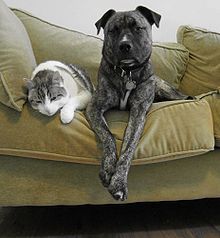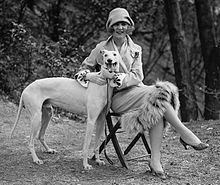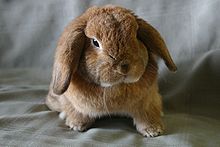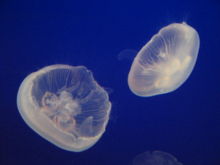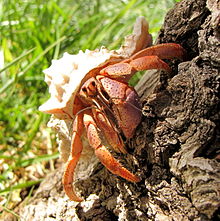- Pet
-
This article is about animals kept for companionship. For "PET" used as an acronym, see PET. For "PETS" used as an acronym, see PETS. For the British comedy Television series, see Pets (TV series). For the microcomputer produced by Commodore Business Machines, see Commodore PET.
A pet is a household animal kept for companionship and a person's enjoyment, as opposed to wild animals or to livestock, laboratory animals, working animals or sport animals, which are kept for economic or productive reasons. The most popular pets are noted for their loyal or playful characteristics, for their attractive appearance, and/or for their song. Pets also generally seem to provide their owners with non-trivial health benefits;[1] keeping pets has been shown to help relieve stress to those who like having animals around. There is now a medically-approved class of "therapy animals," mostly dogs, that are brought to visit confined humans. Walking a dog can provide both the owner and the dog with exercise, fresh air, and social interaction. The most popular pets are dogs and cats, but there are also rodent pets, such as gerbils, hamsters, chinchillas, fancy rats, and guinea pigs, and avian pets, such as canaries, parakeets, or parrots.
Contents
Local restrictions
Many cities and towns have local ordinances limiting the number of pets a person may have, and may also restrict or forbid certain pets, such as exotics. Certain breeds of dog, such as the Pit Bull and Rottweilers, are banned in some places. Dog/other canid/wolf mixes are also banned in some places.
In many locations, animals that are considered pets by their owners but are legally classified as livestock, including horses, pigs, camelids, and fowl may be banned from being kept within the city limits or restricted to property of a certain larger size.
The cities of Berkeley, California and Boulder, Colorado have passed laws stating that people who have pets do not "own" them; rather, they are the pet's "guardian."[citation needed]
Condominium associations and rental properties often
Pet popularity
Around 63% of all U.S. households (71.1 million) have pets, and more than half of these households have more than one animal.[2] The two most popular pets in most Western countries have been cats and dogs. In the United States, a 2007-2008 survey showed that dog-owning households outnumbered those owning cats, but that the total number of pet cats was higher than that of dogs. The same was true for 2009-2010.[3]
-
Most Popular Pets in the U.S (millions)[4][5] Rank Pet Global population U.S. population U.S. inhabited households U.S. average per inhabited household 1 Cat 202 93.6 38.2 2.45 2 Dog 171 77.5 45.6 1.70 3 Fish N/A 171.7 13.3 12.86 4 Small mammals N/A 15.9 5.3 3.00 5 Birds N/A 15.0 6.0 2.50 6 Reptiles & Amphibians N/A 13.6 4.7 2.89 7 Equine N/A 13.3 3.9 3.41
Choice of a pet
The average cost of a dog over its lifetime is estimated at about £20,000 (USD33,152).[6] People most commonly get pets for companionship, to protect a home or property, or because of the beauty/attractiveness of the animals.[7] The most common reasons for not owning a pet are lack of time, lack of suitable housing, and lack of ability to care for the pet when traveling.[7]
United States
According to the 2007-2008 Pet Owners survey:[8]
Animal Number of U.S. households
that own a pet (millions)Total number of pets owned
in the U.S. (millions)Bird 6.0 15.0 Cat 38.2 93.6 Dog 45.6 77.5 Equine 3.9 13.3 Freshwater fish 13.3 171.7 Saltwater fish 0.7 11.2 Reptile 4.7 13.6 Small pets 5.3 15.9 Canada
In Canada the latest survey done by Colin Siren of Ipsos Reid it is estimated that there are 7.9 million cats and 5.9 million dogs in Canada. The survey also shows that 35% of Canadian households have a dog, while 38% have a cat, which is consistent with other surveys conducted around the world.[9]
United Kingdom
A 2007 survey by the University of Bristol found that 26% of UK households owned cats and 31% owned dogs, estimating total domestic populations of approximately 10.3 million cats and 10.5 million dogs in 2006.[10] 47.2% of households with a cat had at least one person educated to degree level, compared with 38.4% of homes with dogs.[11]
Overpopulation
Main article: Overpopulation in companion animalsAnimal protection advocates call attention to pet overpopulation in the United States. According to the Humane Society of the United States, 3-4 million dogs and cats are euthanized each year in the country and many more are confined to cages in shelters. This situation is created by nonneutered animals (spayed/castrated) reproducing and people intentionally breeding animals. A particularly problematic combination of economic hardship combined with a love of animals contributes to this problem in parts of the rural United States.[12] There are also major overpopulation problems with other pet species, such as birds and rabbits. Local humane societies, Societies for the Prevention of Cruelty to Animals (SPCAs), and other animal protection organizations urge people to neuter their pets and to adopt animals from animal shelters instead of purchasing them from breeders or pet stores.
Effects on pets' health
Keeping animals as pets may become detrimental to their health if certain requirements are not kept. An important issue is the inappropriate feeding, which may produce clinical effects (like the consumption of chocolate by dogs). Passive smoking is another recurring problem, aggravated by the fact that fur animals groom themselves, which means taking in extra harmful substances that have landed on their fur, not just those inhaled.
Effects of pets on their caregiver's health
Health benefits
Pets have the ability to stimulate their caregivers, in particular the elderly, giving people someone to take care of, someone to exercise with, and someone to help them heal from a physically or psychologically troubled past.[13] Having a pet may help people achieve health goals, such as lowered blood pressure, or mental goals, such as decreased stress.[14][15][16][17][18][19] There is evidence that having a pet can help a person lead a longer, healthier life. In a study of 92 people hospitalized for coronary ailments, within a year 11 of the 29 without pets had died, compared to only 3 of the 52 who had pets.[13] Pet ownership was shown to significantly reduce triglycerides, and thus heart disease risk, in the elderly.[20]A recent study concluded that owning a pet can reduce the risk of a heart attack by 2% and that pets are better than medication in reducing blood pressure.[citation needed] Owning a pet can also prolong survival of a heart attack.[21] Dogs which are trained to be guide dogs can help people with disabilities. Dogs that are trained in the field of Animal-Assisted Therapy (AAT) can also benefit people with disabilities.
Pets in long-term care institutions
Even pet owners residing in a long-term care facility, such as a hospice or nursing home, experience health benefits from pets. Pets for nursing homes are chosen based on the size of the pet, the amount of care that the breed needs, and the population and size of the care institution.[13] Appropriate pets go through a screening process and, if it is a dog, additional training programs to become a therapy dog.[22] Different pets require varying amounts of attention and care; for example, cats have lower maintenance requirements than dogs.[23]
Health risks
Health risks that are associated with pets include:
- Aggravation of allergies and asthma caused by dander and fur or feathers
- Falling injuries. Tripping over pets, especially dogs, causes more than 86,000 falls serious enough to prompt a trip to the emergency room each year in the United States.[24] Among elderly and disabled people, these falls have resulted in life-threatening injuries and broken bones.
- Injuries, maulings and sometimes deaths caused by pet bites and attacks
- Disease and/or parasites due to animal hygiene problems or lack of appropriate treatment (faeces and urine)
- Stress caused by behaviour of animals
- Fear or distress from animal presence or behaviour
- Spread of diseases like the fatal rabies when not properly taken care of.
Common types
While many people have kept many different species of animals in captivity over the course of human history, only a relative few have been kept long enough to be considered domesticated. Other types of animals, notably monkeys, have never been domesticated but are still commonly sold and kept as pets. There are also inanimate objects that have been kept as "pets", either as a form of game, or humorously (e.g. the pet rock).
Domesticated
Domesticated pets are the most common types of pet. They have consistently been kept in captivity over a long enough period of time that they exhibit marked differences in behavior and appearance from their wild relatives.
Mammals
- Alpacas
- Asses including mules, miniature donkeys, donkeys,
- Cats
- Dogs
- Ferrets
- Hedgehogs
- Horses
- Goats
- Pygmy Goats
- Llamas
- Pot-Bellied Pigs
- Rabbits
- Rodents, including hamsters, guinea pigs, fancy mice, gerbils, chinchillas, plains viscachas, and fancy rats
- Sheep including ewes and lambs
Birds
- Companion parrots, including the budgerigar, lovebird, monk parakeet cockatoo, african grey parrot, macaw, and cockatiel
- Toucans
- Domestic Canary and other finch species
- Chickens
- Domestic turkeys
- Domestic ducks and geese
- Peafowl
- Columbidae
- Ravens and Crows
Fish
Wild
Wild animals are often kept as pets. The term wild in this context specifically applies to any species of animal which has not undergone a fundamental change in behavior to facilitate a close co-existence with humans. Some species listed here may have been bred in captivity for a considerable length of time, but are still not recognized as domesticated. Many of these pets, like insects and fish, are kept as a hobby, rather than for companionship.
Exotic mammals
- Anteaters like giant anteaters and southern tamanduas
- Canidae like arctic foxes, coydogs, dingos, fennec foxes, gray foxes, and wolfdogs
- Civets like binturongs and genets
- Deer like reindeer and leaf muntjacs
- Duikers
- Felidae like bobcats, cheetahs, jaguars, leopards, cougars, lions, ocelots, servals, and tigers
- Marsupials like opossums, koalas, short-tailed opossums, wallabys, wallaroos, and wombats
- Mongoose
- Mustelids like badgers, minks, skunks, and otters
- Primates like capuchin monkeys, chimpanzees, guenons, lemurs, macaques, marmosets, slow lorises, spider monkeys, squirrel monkeys, sykes' monkeys, tamarins, tarsiers, and vervet monkeys - see Pet monkey for more.
- Procyonidae like cacomistles, coatimundi, kinkajous, raccoons, and ringtail cats
- Rodents like chipmunks, degus, dormouse, flying squirrels, groundhogs, patagonian cavys, pouched rats, and prairie dogs.
- Spotted Hyena
- Tapirs
- Sloths such as two-toed sloths and pale-throated three-toed sloths
Birds
Reptiles
- Crocodilians, including alligators, caimans, crocodiles, and gharials
- Iguanas
- Lizards
- Snakes (many of the commonly kept ones like corn, king, milk and other snakes have morphs, which are color or pattern mutations)
- Tortoises
- Turtles
In the period of 2002 to 2005, 30,994,254 were bred for the pet trade. Girondot M . Sex In Common Pet Turtles . WebmedCentral VETERINARY MEDICINE 2010;1(10):WMC00877 Turtles rank fifth as the most common pet behind dogs, cats, fish, and birds. American Pet Product Manufacturers Association. 2011. A turtle is considered a common household pet. (Common household pet means: “A domesticated animal, such as a dog, cat, bird, rodent (including a rabbit), fish, or turtle, that is traditionally kept in the home for pleasure rather than for commercial purposes. Common household pet does not include reptiles (except turtles). “ 24 CFR (Code of Federal Regulations) 5.306 (Title 24 - Housing And Urban Development; Subtitle A - Office Of The Secretary, Department Of Housing And Urban Development; Part 5 -General HUD Program Requirements; Waivers; Subpart C - General Requirements))
Amphibians
Fish
Some of the common freshwater aquarium fishes. For more species of freshwater fishes, please see the list of freshwater aquarium fish species.
- Angelfish (freshwater)
- Barb
- Cichlid
- Corydoras
- Danio
- Discus
- Gourami
- Live-bearer
- Loach
- Mbuna
- Plecostomus
- Rainbowfish
- Rasbora
- Siamese fighting fish
- Tetra
Some of the common marine aquarium fishes. For more species of saltwater fishes, please see the list of marine aquarium fish species.
- Angelfish (marine)
- Blenny
- Boxfish
- Butterflyfish
- Chromis
- Clownfish
- Damsel
- Goby
- Lionfish
- Pufferfish
- Seahorse
- Tang
- Triggerfish
- Wrasse
Jellyfish
Aurelia aurita (moon jellyfish) are becoming popular pets.
- Aurelia aurita (moon jellyfish)
Arthropods
The Caribbean hermit crab is one example of a pet arthropod.
- Ants
- Centipedes
- Cockroaches
- Crabs and Hermit Crabs
- Crickets
- Daphnia
- Millipedes
- Pill Bugs, giant
- Praying Mantises
- Sea Monkeys (a type of brine shrimp)
- Scorpions
- Shrimp (including closely related creatures such as amphipods and branchiopods)
- Stick Insects
- Tarantulas and other spiders can be kept as well
- Triops
- Vinegaroons (whip scorpions)
Molluscs
- Snails
- Cuttlefish
See also: Aquarium
- Octopuses
See also: Aquarium
Non-living
- Digital
- Digital pets such as Gigapets, Neopets, Tamagotchi, or Nintendogs
- Pet rocks - a type of toy; a rock treated as a pet
- Stuffed toys are sometimes treated as pets
- Robotic
- Humanoid robots - robots designed to resemble and interact with humans such as QRIO and ASIMO
- Robotic pets - artificially intelligent robots treated as pets such as Aibo and Genibo
- Robotic stuffed animals - robots covered in fur such as Furby and Zhu Zhu Pets
- Robotic dinosaurs - robots designed to resemble dinosaurs such as Pleo and D-Rex
- Domestic robots - some people treat domestic robots such as Roomba as pets
See also
- Animal Chaplains
- American Animal Hospital Association
- Animal hoarder
- Animal keeping
- Brood parasite
- Dog attack
- Dog grooming
- Human-animal bonding
- P.A.W.S.
- Pet adoption
- Pet cloning
- Pet First Aid
- Pet food
- Pet insurance
- Pet passport
- Pet sitting
- Pet shop
- Pet store
- Pets for vets
- Popular cat names
- The Pet Network
- United States presidential pets
- Category:Veterinary medicine
- Zoonosis
- Pet loss:
- Alternative pets:
References
- ^ "The Health Benefits of Pets". US Government National Institute of Health. http://consensus.nih.gov/1987/1987HealthBenefitsPetsta003html.htm. Retrieved 2006-12-25.
- ^ July 2008, 71 Million Pet Owners And 382 Million Pets Equal A $43 Billion Industry That Shows No Signs Of Slowing, IBISWorld
- ^ "Household Pet Ownership: 2001". US Census Bureau. http://www.census.gov/compendia/statab/tables/07s1227.xls. Retrieved 2007-09-17.[dead link]
- ^ Susan Hayes. "What are the most popular pets around the world?". PetQuestions.com. http://www.petquestions.com/12502/what-are-the-most-popular-pets-around-the-world/. Retrieved 2011-03-04.
- ^ "Industry Statistics & Trends". American Pet Product Association. http://www.americanpetproducts.org/press_industrytrends.asp. Retrieved 2011-03-04.
- ^ Dogs cost £20,000 over a lifetime, press release, Churchill Insurance, 07/03/2005
- ^ a b Leslie, Be; Meek, Ah; Kawash, Gf; Mckeown, Db (April 1994). "An epidemiological investigation of pet ownership in Ontario" (Free full text). The Canadian veterinary journal. La revue veterinaire canadienne 35 (4): 218–22. ISSN 0008-5286. PMC 1686751. PMID 8076276. http://www.pubmedcentral.nih.gov/articlerender.fcgi?tool=pmcentrez&artid=1686751.
- ^ "Industry Statistics & Trends". American Pet Products Manufacturers Association, Inc. http://www.americanpetproducts.org/press_industrytrends.asp. Retrieved 2009-12-14.
- ^ "Latest Pet Population Figures Released" (PDF). Canadian Animal Health Institute. https://www.aaaht.com/members/documents/PressRelease-PetSurvey-November15.pdf. Retrieved 2008-07-26.
- ^ "UK domestic cat and dog population larger than thought". University of Bristol. 6 February 2010. http://www.bristol.ac.uk/news/2010/6826.html.
- ^ "More cat owners 'have degrees' than dog-lovers". BBC News Online. 6 February 2010. http://news.bbc.co.uk/1/hi/uk/8501042.stm.
- ^ Eckholm, Erik (2007-06-30). "For Poor Families, an Added Burden of Too Many Pets". The New York Times. http://www.nytimes.com/2007/06/30/us/30dogs.html?ex=1340942400&en=914cf2d080113914&ei=5124&partner=permalink&exprod=permalink. Retrieved 2007-06-30.
- ^ a b c Whiteley, Ellen H. (1986). "The Healing Power of Pets". 258. Saturday Evening Post. pp. 2–102. http://search.ebscohost.com/login.aspx?direct=true&db=afh&AN=12592944&site=ehost-live. Retrieved 2006-11-05. Academic Search Elite. EBSCOhost. Polk Library, UW Oshkosh
- ^ Asp, Karen (2005). "Volunteer Pets". Prevention 57 (4): 176–78. http://search.ebscohost.com/login.aspx?direct=true&db=afh&AN=16471647&site=ehost-live. Retrieved 2006-11-05. Academic Search Elite. EBSCOhost. Polk Library, UW Oshkosh
- ^ Allen, K; Shykoff, Be; Izzo, Jl, Jr (1 October 2001). "Pet ownership, but not ace inhibitor therapy, blunts home blood pressure responses to mental stress" (Free full text). Hypertension 38 (4): 815–20. ISSN 0194-911X. PMID 11641292. http://hyper.ahajournals.org/cgi/pmidlookup?view=long&pmid=11641292.
- ^ Kingwell, Ba; Lomdahl, A; Anderson, Wp (October 2001). "Presence of a pet dog and human cardiovascular responses to mild mental stress". Clinical autonomic research 11 (5): 313–7. doi:10.1007/BF02332977. ISSN 0959-9851. PMID 11758798.
- ^ Wilson, Cc (October 1987). "Physiological responses of college students to a pet". The Journal of nervous and mental disease 175 (10): 606–12. doi:10.1097/00005053-198710000-00005. ISSN 0022-3018. PMID 3655768.
- ^ Koivusilta, Leena K.; Ojanlatva, A; Baune, Bernhard (2006). Baune, Bernhard. ed. "To Have or Not To Have a Pet for Better Health?". PLoS ONE 1 (1): e109. doi:10.1371/journal.pone.0000109. PMC 1762431. PMID 17205113. http://www.pubmedcentral.nih.gov/articlerender.fcgi?tool=pmcentrez&artid=1762431.
- ^ Vormbrock, Jk; Grossberg, Jm (October 1988). "Cardiovascular effects of human-pet dog interactions". Journal of behavioral medicine 11 (5): 509–17. doi:10.1007/BF00844843. ISSN 0160-7715. PMID 3236382.
- ^ Dembicki, D and Anderson, J. 1996. Journal of Nutrition in Gerontology and Geriatrics. Volume 15 Issue 3, pages 15-31.
- ^ "25 Tricks to Look younger". AOL Health. August 2009. http://www.aolhealth.com/healthy-living/healthy-beautiful-you/natural-beauty-tips. Retrieved August 2009.
- ^ Huculak, Chad (4 October 2006). "Super Furry Animals". Edmonton: W7.. LexisNexis. Polk Library, UW Oshkosh. 5 Nov. 2006.
- ^ Bruck, Laura (1996). "Today's Ancillaries, Part 2: Art, music and pet therapy". Nursing Homes: Long Term Care Management 45 (7): 36. http://search.ebscohost.com/login.aspx?direct=true&db=afh&AN=9608232012&site=ehost-live. Retrieved 2006-11-05. Academic Search Elite. EBSCOhost. Polk Library, UW Oshkosh.
- ^ "In the Home, a Four-Legged Tripwire". The New York Times. 27 March 2009. http://www.nytimes.com/2009/03/28/health/28pets.html?ref=health.
External links
Categories:- Pets
- Human-animal relationships
-
Wikimedia Foundation. 2010.

